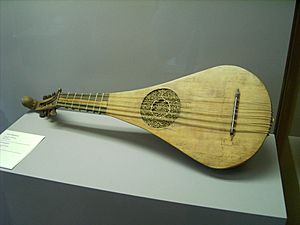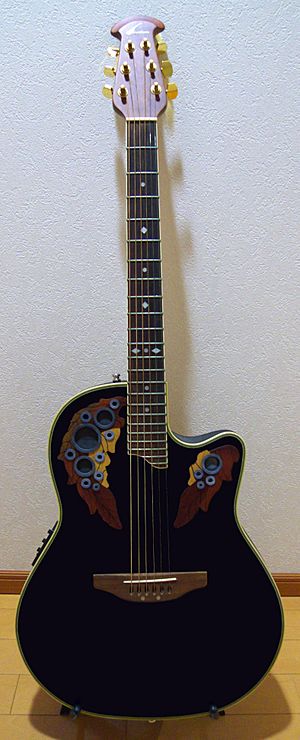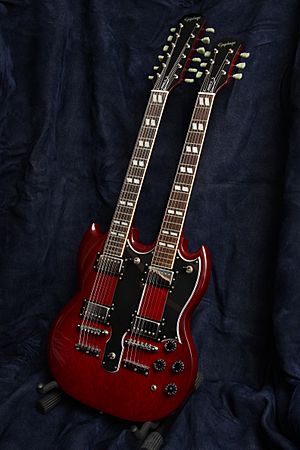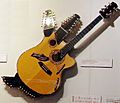Acoustic guitar facts for kids
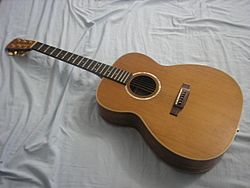
An acoustic guitar
|
|
| Classification | String |
|---|---|
An acoustic guitar is a type of guitar that makes sound naturally. It doesn't need to be plugged into an amplifier like an Electric guitar. Instead, the sound comes from the strings vibrating and sending those vibrations through the guitar's body.
When you pluck or strum a string, it vibrates very fast. These vibrations travel to a special part called the soundboard and into the hollow sound box of the guitar. This makes the sound much louder and richer. The way the soundboard and sound box vibrate also changes the guitar's unique sound, called its timbre.
Contents
The History of Acoustic Guitars
The first instruments that looked a bit like guitars were called Gitterns. These small, plucked instruments appeared in the Middle Ages. They had a round back, similar to a lute. Guitars started to look more like their modern shape during the Renaissance period.
France played a big role in making guitars popular and producing many of them. While Spain is often called the "home" of the guitar, we know more about the early guitar makers and musicians in France.
By the 1800s, guitars changed from having pairs of strings (called "courses") to having six single strings, just like most guitars today.
How Acoustic Guitars Make Sound

The soundboard, or top, of an acoustic guitar is very important for how loud it sounds. When you pluck a string, it vibrates. But a string alone can't move much air. The soundboard is large and flat, so it can move a lot more air. This makes the sound much louder.
No extra energy is added to make the sound louder, like with an electronic Amplifier. All the energy comes from your fingers plucking the string. The soundboard just helps to transfer that energy into the air more easily.
Acoustic guitars also have a hollow body. This hollow space helps to make the lower sounds even louder. The way the air moves inside the guitar and how the different parts vibrate together gives each guitar its special sound. This sound is a mix of many different musical notes called harmonics.
Making Guitars Louder
Older classical guitars, which used gut strings, were not very loud. This made it hard for them to be heard over other instruments like banjos in bands.
Two big changes helped make guitars louder. The American company Martin Guitars made these improvements. First, they started using steel strings instead of gut strings. Steel strings make a much louder sound. Second, Martin made the guitar tops bigger. The larger "dreadnought" guitar body became very popular because it produced a much bigger sound.
These changes allowed guitars to become popular in jazz bands, often replacing banjos. Steel strings put more tension on the guitar's neck. To make the neck stronger, Martin added a steel rod inside it, called a truss rod. This became a standard feature in most steel-string guitars.
You can also make an acoustic guitar louder by adding special microphones or "pickups." However, sometimes this can cause a loud, unwanted noise called audio feedback.
Different Kinds of Acoustic Guitars
Acoustic guitars come in many different shapes and sizes. They are much more varied than electric guitars. Some of the most common types are the classical guitar (which uses nylon strings) and the steel-string acoustic guitar.
Guitars with Nylon or Gut Strings
- Vihuela
- Gittern
- Baroque guitar
- Romantic guitar
- Classical guitar
- Flamenco guitar
- Russian/Gypsy guitar
- Lute
Guitars with Steel Strings
- Steel-string acoustic guitar (also known as western, folk, or country guitar)
- Twelve string guitar
- Resonator guitar
- Archtop guitar
- Selmer/Maccaferri (Manouche) guitar
- Battente guitar
- Lap steel guitar
- Lap slide guitar
- Parlor guitar
- Lyre-guitar

Other Types of Acoustic Guitars
- Harp guitar
- Pikasso guitar
- Contraguitar
- Acoustic bass guitar
- Banjo guitar
Images for kids
See also
 In Spanish: Guitarra acústica para niños
In Spanish: Guitarra acústica para niños



